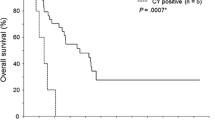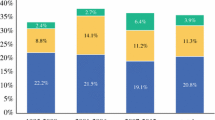Abstract
Background
Our aim was to investigate the presence of free cancer cells found in lavage cytology specimens taken from the proximity of tumors during the course of curative open and laparoscopic colorectal resections and then examine and compare the long-term disease outcomes in cases of negative and positive cytology. Based on the results, we were hoping to identify the place of peritumoral lavage cytology among prognostic factors for disease recurrence.
Methods
Between January 1, 2005 and December 31, 2007 intraoperative peritoneal lavage cytology was performed in 145 patients who underwent curative colorectal procedures. In all, 37 of the procedures were laparoscopic resections.
Results
Malignant cells were detected in the intraoperative peritoneal lavage cytology samples from 25 patients. Median follow-up was 47 months (3–81 months). Among the 25 patients with positive cytology; locoregional recurrence or distant metastasis was found in 14 during this period (56 %), whereas among the 120 patients with negative cytology the incidence was 28 (23 %).
Conclusions
The impact of tumor stage, lymph node status, and peritoneal lavage cytology on recurrence rates is significant. Tumor, nodal, and lavage cytology status can be organized hierarchically in relation to time of recurrence. Cytology is most important, with positivity rendering long-term prognosis unfavorable. When comparing surgical techniques (open versus laparoscopic), we found no significant difference in recurrence rates. Our study has shown that conventional peritoneal lavage cytology is a prognostic factor in the case of patients undergoing curative colorectal operations.

Similar content being viewed by others
References
Kanellos I, Demetriades H, Zintzaras E et al (2003) Incidence et prognostic value of positive peritoneal cytology in colorectal cancer. Dis Colon Rectum 41:535–539
Yamamoto S, Akasu T, Fujita S et al (2003) Long term prognostic value of peritoneal cytology after curative resection for colorectal carcinoma. Jpn J Clin Oncol 33:33–37
Ambrose NS, MacDonald F, Young J et al (1989) Monoclonal antibody and cytological detection of free malignant cells in the peritoneal cavity during resection of colorectal cancer: can monoclonal antibodies do better? Eur J Surg Oncol 15:99–102
Leather AJM, Kocjan G, Path MRC et al (1994) Detection of free malignant cells in the peritoneal cavity before and after resection of colorectal cancer. Dis Colon Rectum 37:814–819
Hase K, Ueno H, Kuranaga N et al (1998) Intraperitoneal exfoliated cancer cells in patients with colorectal cancer. Dis Colon Rectum 41:1134–1140
Wind P, Nordlinger B, Roger V et al (1999) Long term prognostic value of positive peritoneal washing in colon cancer. Scand J Gastroenetrol 34:606–610
Gerhard M, Juhl H, Kalthoff H et al (1994) Specific detection of carcinoembryonic antigen-expressing tumor cells in bone marrow aspirates by polymerase chain reaction. J Clin Oncol 12:725–729
Vogel P, Rüschoff J, Kümmel S et al (2000) Prognostic value of microscopic peritoneal dissemination: comparison between colon and gastric cancer. Dis Colon Rectum 43:92–100
Wittekind CH, Meyer HJ, Bootz F (eds) (2002) TNM Klassifikation maligner Tumoren, 6th edn. Springer, Berlin
Vogel I, Francksen H, Soeth E et al (2001) The carcinoembryonic antigen and its prognostic impact on immunocytologically detected intraperitoneal colorectal cancer cells. Am J Surg 181:188–193
Schott A, Vogel I, Krueger U et al (1998) Isolated tumor cells are frequently detectable in the peritoneal cavity of gastric and colorectal cancer patients and serve a new prognostic marker. Ann Surg 227:372–379
Van de Molengraft FJ, Van’t Hof MA, Herman CJ et al (1982) Quantitative light microscopy of a typical mesothelial cells and malignant cells in ascitic fluid. Anal Quant Cytol 4:217–220
Krivinkoa H, Pontén J, Blöndal T (1976) The diagnosis of cancer from body fluid. Acta Pathol Microbiol 84:455–467
Skipper D, Cooper AJ, Marston JE et al (1987) Exfoliated cells and in vitro growth in colorectal cancer. Br J Surg 74:1049–1052
Gircouroff G (1967) Pathogenesis of recurrences on the suture line following surgical resection for carcinoma of the colon. Cancer 20:673–676
Umpleby HC, Ferrmor B, Symes MO et al (1984) Viability of exfoliated colorectal carcinoma cells. Br J Surg 71:659–663
Horattas MC, Evasovich MR, Topham N (1997) Colorectal carcinoma and the relationship of peritoneal cytology. Am J Surg 174:334–338
Author information
Authors and Affiliations
Corresponding author
Rights and permissions
About this article
Cite this article
Temesi, R., Sikorszki, L., Bezsilla, J. et al. Impact of Positive Intraabdominal Lavage Cytology on the Long-term Prognosis of Colorectal Cancer Patients. World J Surg 36, 2714–2721 (2012). https://doi.org/10.1007/s00268-012-1713-y
Published:
Issue Date:
DOI: https://doi.org/10.1007/s00268-012-1713-y




